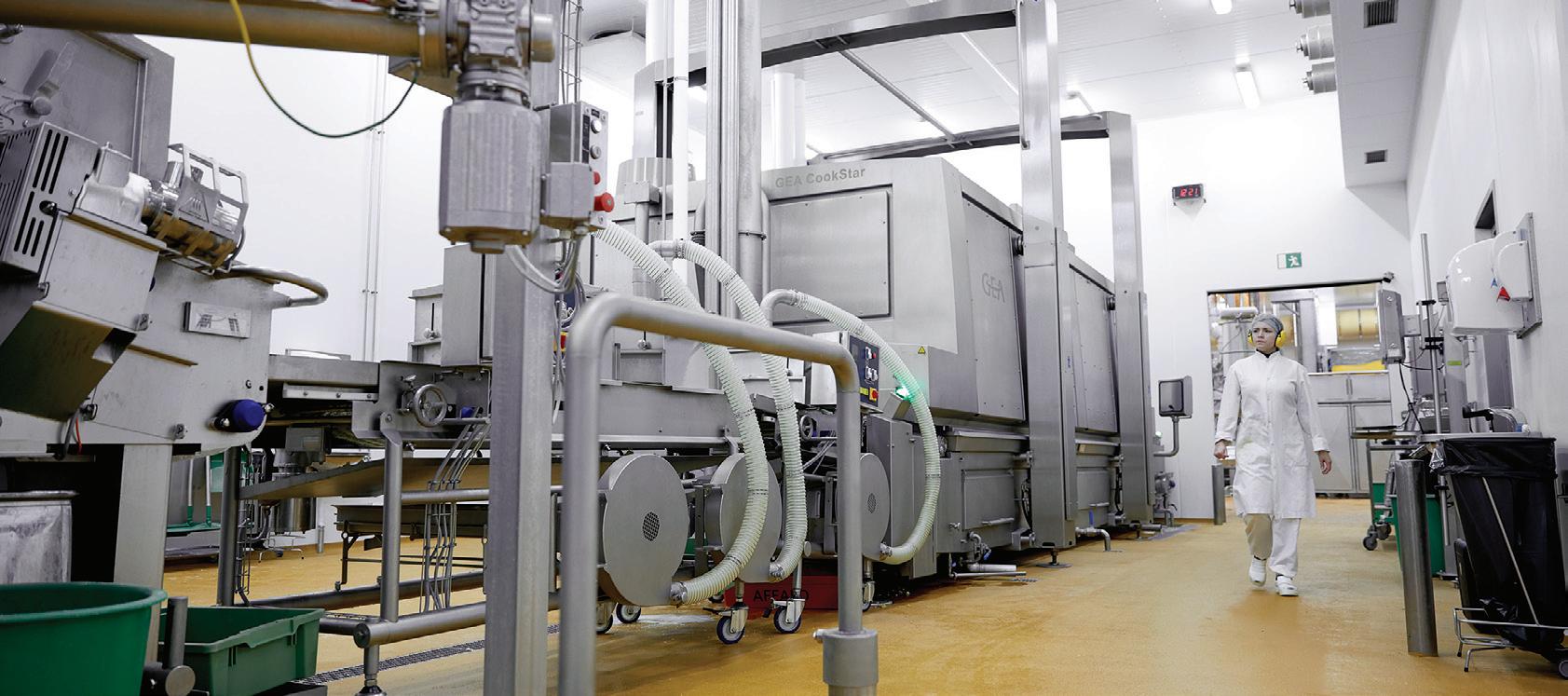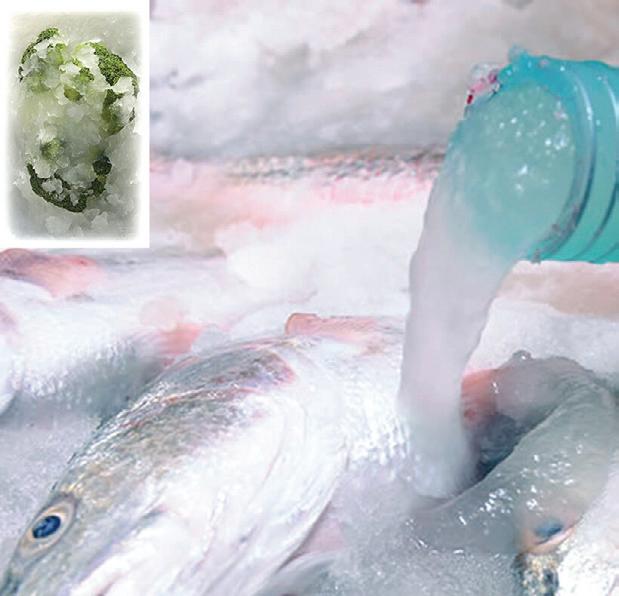
15 minute read
What’s the missing ingredient for for chocolate supply chains?
Astudy from the University of Surrey has revealed that biotechnology could be the missing ingredient in helping cocoa farmers get a better deal for their beans.
Chocolate is an AU$114 billion-per-year global industry that has seen the volatile price of cocoa lead to a surge in traders seeking to buy cheaper beans, which has affected the prices and practices of legitimate farmers using sustainability practices.
In the findings, published in the journal Supply Chain Management, the multi-university research team reveal that biomarkers can create ‘meta-barcodes’, which are like biochemical fingerprints, an unchanging barcode extracted from the plant’s DNA, providing a unique identifier of a plant that is also observed in its beans and subsequent chocolate products. The biomarker of cocoa beans used in chocolate manufacturing could accurately identify the farm, production facility or cooperative where a cocoa product came from.
To make this new process a reality, a controlled data set of biomarkers of registered locations is required for audit. The study goes on to explain that this missing piece — a biomarker database that identifies the origin of cocoa products — can be built by companies at an estimated cost of £5 (AU$9) per sample, which is around the cost of a box of chocolates.
Glenn Parry, Professor of Digital Transformation at University of Surrey, said: “The chocolate market has become turbulent, and we have evidence of over 100 years of slavery in the supply chain. Governments and chocolate producers are faced with an ethical challenge and drastically need to improve a trade that is rife with environmental destruction and human misery.
“We have an effective approach for them to make progress. We demonstrate that biomarkers can provide supply chain visibility from the individual farm to the retail chocolate bar. This solution could now be within reach, where the journey of the chocolate in your fridge could be traced back to the cocoa trees where it began.”


Labelling seafood made from fish cells
While Australia has a Senate Inquiry into food labelling of plant-based meat, in the US a study has looked at what to call seafood made from fish cells.
According to a recent Rutgers study in the Journal of Food Science, terms such as ‘cellbased’ or ‘cell-cultured’ should be used when labelling and talking about seafood products made from the cells of fish or shellfish.
The U.S. Food and Drug Administration and U.S. Department of Agriculture require food products to have a “common or usual name” on their labels, so consumers can make informed choices.
With more than 70 companies around the world developing cell-cultured protein products and more than $360 million invested in their development in 2020 alone, the adoption of one common name is crucial as products move closer to commercialisation.
The study by William Hallman, a professor who chairs the Department of Human Ecology in the School of Environmental and Biological Sciences at Rutgers University-New Brunswick, confirmed the results from his earlier study comparing seven potential names for these products.
In the new study, a representative sample of 1200 consumers evaluated packages of Atlantic salmon designed to mimic those found in grocery stores, labelled with ‘cellbased seafood’ or ‘cell-cultured seafood’.
The names were evaluated using five criteria: • ability to help consumers distinguish cell-cultured seafood from wild and farmed fish; • to signal its potential as an allergen; • to be seen as an appropriate term for the product; • to not disparage cell-cultured or conventional products; and • to not evoke thoughts, images or emotions that the products aren’t safe, healthy and nutritious.
“The results suggest that both ‘cell-based seafood’ and ‘cell-cultured seafood’ meet FDA regulations,” Hallman said.
“They help the majority of consumers understand that the new products are produced in a different way from the ‘wild-caught’ and ‘farm-raised’ fish they may already be buying. At the same time, consumers also recognised that if they are allergic to seafood, they shouldn’t eat the product.
“Both names work well. The key is to choose a single term and to get everyone to adopt it. That will reduce confusion and ultimately help consumers understand what they are buying.”
Livestock processing facility to be built in South Australia
CirPro (Australia), formerly Pirie Meats, and Siemens have signed a memorandum of understanding (MoU) that outlines ways in which the two companies will cooperate in CirPro’s design, development and implementation of a livestock processing facility in Port Pirie. Siemens is set to provide technological and infrastructural solutions that will assist in developing the facility with Industry 4.0 in mind.
“This MoU with Siemens means that we have access to knowledge across the broadest spectrum of technology with a single technology company. What I really want out of this is to develop a view of what’s possible — and I can’t think of another company that could deliver the breadth and depth of knowledge and technology offerings that Siemens can,” said CirPro CEO Reg Smyth.
“Embracing Industry 4.0 is critical as we prepare our competitive place in the world. But when it comes to business, what’s most important is the objectives such as speed, resource efficiency, flexible production, scalability, sustainability and so on. This is what drives competitiveness. When you look at this holistically against the technology solutions available today in digitalisation, automation and energy efficiency, you can achieve amazing outcomes. However, to really achieve maximum efficiency you need to include all aspects of the business end to end — everything from interactions with your supply chain to cybersecurity, smart building technologies and even types of skills needed to operate the plant,” explained Jeff Connolly, CEO of Siemens Australia.
CirPro has committed to a circular processing model and the aims to reduce methane emissions from livestock with a seaweed diet supplement, hence the change of name from Pirie Meats.
“Embracing Australian innovation and advanced plant technologies from Siemens in this way is exciting, but will present challenges and require collective commitments to support an industry transformation that will create new market opportunities for Australian products, greater resilience and increased returns to farmers through to value-add product manufacturers. Siemens support for comprehensive digitalisation and traceability across this new supply chain will be fundamental to informing and protecting the quality, integrity, value and future growth of all products that come through our new facility,” Smyth said.
Subject to detailed design completion and final Development Approval, CirPro is focused on commencing construction as soon as possible with processing commencing by early 2023.

NEWS
MEAT, POULTRY & SEAFOOD Natural preservative for cured meats

©stock.adobe.com/au/Maksim Shebeko
Researchers at the University of Reading and other scientists have been on the lookout for alternatives to nitrite in processed meat and now they have found an unlikely plant-based solution.
Japanese knotweed is a fast-growing plant, feared by homeowners for its ability to invade gardens and buildings. However, researchers have now found that this annoying plant contains a chemical which could take the place of the nitrite preservative in cured meats such as bacon and sausages.
The PHYTOME project has developed processed red meat that includes added natural substitutes, reducing the carcinogenic compound nitrite added to preserve meats. The range of sausages and hams had a mixture of plants and fruits added to them which included rosemary, green tea, and resveratrol — an extract taken from Japanese knotweed.
As well as developing versions of cooked and dry cured red meats which replaced nitrite with these natural alternatives, the project also tested whether those substitutes would have an effect alongside normal nitrite levels found in processed red meats.
In a paper published in Molecular Nutrition and Food Research, the international team of scientists have tested the specially formulated products against conventionally processed red meat as well as white meat.
They found that tell-tale signs of nitrite content in participants’ faeces were significantly lower from both specially formulated meats, and levels were like those who were fed on minimally processed white meat.
Gunter Kuhnle, Professor of Nutrition and Food Science at the University of Reading, said:
“The ongoing worries about highly processed red meat have often focused on the role of nitrite, and its links with cancer. The PHYTOME project tackled the issue by creating processed red meat products that replace additives with plant-based alternatives.
“Our latest findings show that using natural additives in processed red meat reduces the creation of compounds in the body that are linked to cancer.
“Surprisingly, the natural additives seemed to have some protective effects even when the red meat still contained nitrite. This suggests that natural additives could be used to reduce some of the potentially harmful effects of nitrite, even in foods where it is not possible to take out nitrite preservatives altogether.”
A major consideration for the team was how the nitrate content in drinking water can significantly affect the formation of nitrite, which is produced in the body, as found in previous research.
The team controlled for this by controlling water content during the trial and participants were tested with both low and high nitrate-containing water across separate testing periods.
By controlling for drinking water, the results showed that PHYTOME red meats produced lower levels of the tell-tale signs of nitrite production in the body than either conventional red meat, or the unprocessed white meat.
Sausage twist linker
The Mainca PR-360 attaches to a user’s existing hydraulic filler and automatically portions and twists the filled casing to create linked sausages. Suitable for the small–medium sausage maker looking to fill, portion and twist at once, the device is designed to improve product quality, consistency and production efficiency, and removes the need for skilled labour.
It works with natural, collagen, polyamide or cellulose casings and is suitable for both fine emulsions and coarse minced products. Capable of up to 1 link per second, the device has no limits on portion size, length, weight, number of twists, or twisting speed.
It performs best with fillers that have a lever locking mechanism and a variable pressure control knob, as this allows for hands-free operation (when using collagen casing) and a consistent flow of product.
The device connects via the filler nozzle nut. It runs a single-phase motor (230 V, 50 Hz) but requires no electrical connection between it and the filler. Constructed in stainless steel 18/10 and polyethylene, it is fully compliant with EC regulations.
Barnco Pty Ltd
www.barnco.com.au

CASE STUDY Wastewater pump for Junee Prime Lamb

Junee Prime Lamb is one of the leading producers of premium quality lamb in Australia. A family-owned and -operated business since 1997, the company specialises exclusively in prime Australian lamb, and supplies its products to many parts of the world.
Its lamb processing facility, which is located on the outskirts of Junee, occupies 182,000 m2 and employs nearly 300 highly trained staff. The production line is equipped with the latest technology to maintain strict hygiene standards and the business regularly reviews its processes to ensure they meet the highest quality standards for the industry.
When Operations Manager Scott Newton needed a wastewater pump for the facility, he wanted to source the best and most reliable product for the job. Newton already had quite a lot of experience with Gorman Rupp self-priming pumps at another large NSW abattoir and because of their history of reliability, ease of maintenance and long service life [even when operating in very harsh conditions], he opted for Gorman Rupp pumps again in the Junee upgrade.
The team at Hydro Innovations offered a Gorman-Rupp T3A60S-B “Super T Series” self-priming solids handling pump. It is capable of handling solids up to 63 mm and also stringy materials because of its “self-cleaning wear plate system”. The pump also has a lightweight inspection cover-plate to allow quick access for operators to inspect pump internals or remove large pieces of debris. Being self-priming, it could be located at surface level, up to 7.5 m above the wastewater level.
©stock.adobe.com/au/freeskyline
The result
Newton has been very happy with his investment and firmly believes that buying quality equipment provides not only tangible returns in operational efficiency, but also intangible returns in peace of mind.
The Gorman-Rupp Super T Series range is available in sizes from 2” [50 mm] through to 10” [250 mm], with flows from 3 L/s through to 200 L/s. The range is also available in various materials of construction to suit specific applications, such as stainless steel components for corrosive wastewater and hardened components for abrasive fluids. Hydro Innovations www.hydroinnovations.com.au



CASE STUDY
Let the process flow

Producing large quantities of popular fast-food items such as chicken nuggets with consistent, repeatable results every time is a highly sensitive process. As leading global brands place increased emphasis on demanding specifications for product quality, this has become a fine art. Any marginal deviation on a production line can affect the quality, and it already starts at the basis of the product — the viscosity of the meat mixture. Not having that under full control will ultimately affect the finished product at the end of the process.
GEA has now designed a solution called Batch2Flow to secure the production process, save energy and water and significantly reduce the use of cleaning chemicals.
Maintaining a safe temperature of the ingredients is especially crucial in the process of making chicken nuggets. Not only does this help to prevent spoilage, it also helps to ensure that the optimum viscosity of the meat mixture is maintained throughout the initial forming process, leading to successful, perfectly created nuggets.
But that takes a lot of energy use, with specialised chilled rooms to store meat between the mixing and forming stages of the process. In addition, the process is relatively complicated and susceptible to human mistakes.
To move the mixed product from the mixer to the former, most producers use standard 200 L trollies. It’s hard physical work, and inevitably, there’s a time delay between the meat leaving the mixer and entering the former. At this point, it depends on the operator to ensure that no contamination enters the mix.
Industrial mixers work quickly, so before the first trolley can be loaded into the former, the next batch is filling up another trolley. So, one person has to quickly move the trolleys into a cold store while another moves them one by one from the cold store to the former. In the meantime, the optimum temperature and viscosity of the mix is starting to deteriorate as it moves towards the ambient temperature. And, if a trolley gets forgotten, it results in costly wastage as the contents will have to be disposed of. In the worst-case scenario, a forgotten trolley could be mistakenly loaded into the former, seriously risking the food safety of the product.
Even when all goes to plan there is wastage, as residue remains within the trolleys, so these have to be cleaned repeatedly with hot water and chemicals.
Automated link between mixing and forming
Batch2Flow is designed to eliminate these difficulties by moving the mix rapidly along a conveyor system from the mixers straight into the former, and the mixers have special unloading steps to allow controlled portion delivery onto the conveyor. As a result, it will be at the right temperature and viscosity when it reaches the former. No energy-consuming cold stores are needed, food waste is avoided, cleaning costs can be reduced and there is full traceability as nothing is removed from the line.
GEA noticed that the cold metal trolleys in a forming line had a tendency to attract moisture — condensation which has the potential to drip off and contaminate the mix when the trolley is tipped upside down and emptied into the former. And in tipping the trolleys upside down, the four wheels which have been on the floor are exposed above the product, time and time again. Batch2Flow is designed to remove these risks, while minimising waste and reducing energy consumption.
The solution from GEA features customised discharge gates, as well as specialised machine and line software, and allows a fully seamless process.
GEA Group www.geagroup.com.au


Fresh food preservation methods
Increasing demand for fresher, sustainable and higher quality food puts a strong pressure on producers of highly delicate foods such as fish and seafood, meat and poultry, and fresh produce. It’s not just about how good the quality of product is from moment of harvest, but rather, preserving that quality throughout every moment, from harvest, through the entire process and supply chain to finally reaching end consumers at markets or hitting the plates at homes and restaurants.
ChillPro Systems brand ChillPro FRESH is a next-generation Liquid ICE preservation technology that preserves, maintains and increases the quality of a catch or harvest. The ice technology comprises millions of micro-crystals generated from water and delivered in a Liquid ICE form to fully coat the outside of a product. Unlike flake ice and other traditional methods of preservation, the Liquid ICE technology creates full contact with the product surface, lowering temperatures instantly, preserving the ‘just harvested’ quality and reducing bacterial growth and spoilage. The Liquid ICE is produced, stored and pumped through sealed piping, which enables ease of use, CIP and no exposure to outside contaminants.
The ice crystals contain high latent energy, simultaneously chilling and hydrating the product. This reduces shrinkage and prevents weight loss of product, which can enhance profitability.
ChillPro FRESH Liquid ICE systems are used in applications from processing of fish to instant cooling of dairy products below 4°C such as yoghurts, creams, dips and spreads. ChillPro FRESH machines and system configurations are scalable for use onboard vessels, for land-based producers and processers, in-field or storage cooling, short-haul transport and retail outlets. Automated and easy to use, the systems are designed to save on labour costs and benefit towards carbon neutral goals.
ChillPro Systems Pty Ltd
www.chillprosystems.com










